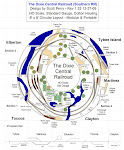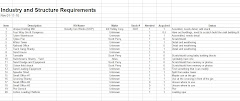This is my new personal heater that Marie gave me. It is fantastic! Blows just the right amount of heat and has a thermostat system. The shop has central heat but when it gets to 17 degrees this little unit adds some extra comfort to my fingers trying to pick up small parts. This shot was taken just before my four year old spilled hot chocolate on it. !@$!@#@
Speaking of hot chocolate it has started to get a little old. So I dug out my mother's recipe for Russian Tea. I'll pot it at the end of the blog today. It is tangy and hot, but not so heavy as hot chocolate.
Here is the cocoa monster who was promptly banished from the shop earlier this evening.
Here are today's acquisitions from Steve-Mart, The Best in Basement Bargains! This about raps it up for the Procurement Department as I think I have everything but a few turnouts.
Perfect! A chlorine car. One, because I work for Clorox and I think it is cool. Two, because knitting mills use chlorine for bleaching things white. It is unusual and will weather up great.
This tank car will be used for cotton seed oil transportation. A bit of a stretch, but we'll take it.
This Southern flat was a must have! I'll loose the loads and put on something that works for my railroad.
An L&N flat car, too! Yeah! I love L&N.
Another fine Southern box car with a different roadname. The doors open, which was a parameter.
The Head of Engineering for Structures went with me an bought a few things, too.
Not sure where it will go, but you can't have too many of these small buildings laying around. They are great for a lot of things.
This crossing shanty will be at the 30 dgree crossing at the cotton gin.
This may go on the pier unless I scratchbuild one.
Or this one may go on the pier. The extra doors make more sense for it than the big door.
I'm not sure if I'll use this as the cotton siding or not, but it looked great and is much easier than scratchbuilding.
This is awesome! A derrick! The booms are a bit long for what I'm doing but the base and pulleys are fantastic. I'll get great use from this.
Paul Voelker powers his layout with Stegosaurs so I bought this older Mark II unit for local switching.
The next chore was to work on the pier. I finished adding the 1/8" x 1/8" strips to the long wall untill they were all gone. I'll put her aside until next weekend.
My daughter has been coming down to visit more so I'm trying to be more carefully with blades. I'll start keep them in a tray instead of laying around.
With a fleet of used cars in the yard I had better get to getting them ready. This is a test board that I built years ago for a clinic. It has nine stations for testing a car or locomotive and is small so you can take it upstairs and watch TV or whatever while checking out your fleet. Let's take a look at it...
The first thing is to clean it. The track is dirty from sitting under the workbench. A "Brite Boy" type block is used to clean the tops of the rail. Clean is not the right word. Grind might be better. All it does is remove corrosion and soil by abrasion.
The cleaning part happens when you put alcohol on a towel and wipe the rail down after scrubbing. Yuck! Some folks use Wahl Clipper oil or White oil to clean the track, but I've not had much luck with either. Love to hear how YOU clean track! Post a comment below.
Station One is a test track for code 83 rail. This demonstrates how old this test board is because when I built it many rail cars had thick flanges that wouldn't roll on Code 83. Now most all cars are ready for it. If I was to rebuild this test board I'd use code 70.
Station Two is free rolling. There is a slight incline here and I push the car to see it go up the incline on its own without stalling.
Station Three is the grade test. I sit the car on this 2% grade and it should roll off the other end of the track. Yes, I catch it!
Station Four is code 100 track. This track is carefully gauged and checked. The test here is to see if the trucks are working correctly. My next test board will have a sharp curve in it instead of a tangent track.
Station Five is flange depth and balance. I used to put rerailers on hidden track all the time to help keep the train wheels in alignment and railed. However, you can't get these for Code 83. Hey Walthers or somebody, its still a good idea to have these! If the weight in the car is not balanced this rerailer will make it wobble.
Station Six is the coupler height and hose gauge test. I sit the gauge here and test the coupler, the coupler's height, the hose height and the basic operation of both couplers. The rerailler just to the left is helpful for putting the car back on the track repeatedly during adjustments.
Here is the Kadee coupler height gauge. It is not mounted because I have an On30 gauge and use the same board for testing.
Station Seven is the DC/DCC test and programming track. This is mostly for locomotives, but can be used for cabooses or passenger cars with lighting.
Station Eight is for testing engine lights and sound and is a flat spot of track.
Station Nine is the last station and is for cleaning locomotive drivers. The track has cuts in it that grab dirt and clean the wheels.
Other equipment I use for car testing and maintenance are...
Gram Scale. This is actually an ounce scale and is very old. I'm saving up to buy a nice digital gram scale. This is for the precision weighing of cars per NMRA guidelines.
Loco Caddy or Car Caddy. This is a foam block that has grooves for holding the rail car upside down for truck repair or coupler installation.
HO Standards Gauge. This is used for checking the gauge or the distance between the wheels and is critical for good performance. I keep a lot of these laying around for track installation, too.
At the bottom of the gauge near my thumb are two small grooves. The flanges of a car's wheels should fit in the grooves. You can buy these at any hobby shop or directly from the NMRA.
I started with the N&W car. It failed right off the bat on rolling as it has plastic wheels and the railroad mandates metal wheels. I continued to check the couplers and make adjustments.
Using a special set up curved-jaw pliers I adjusted the coupler "hoses" or trip pins upward so they would clear the gauge.
As I make adjustments I make notes. This is too time consuming so I'm going to make a print out for this and just fill it out. I ONLY do this when there are repairs and parts to be ordered and installed.


















































No comments:
Post a Comment